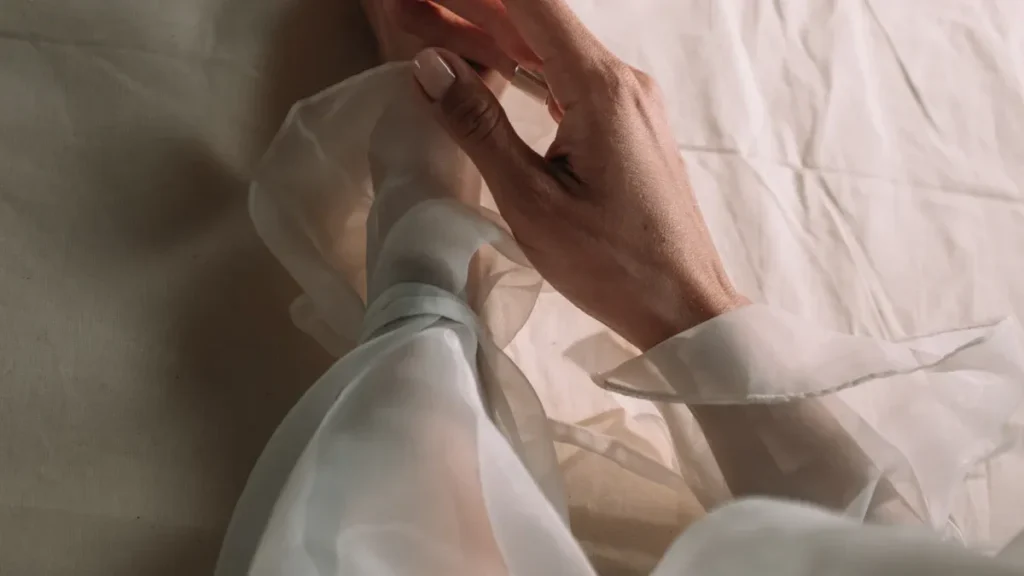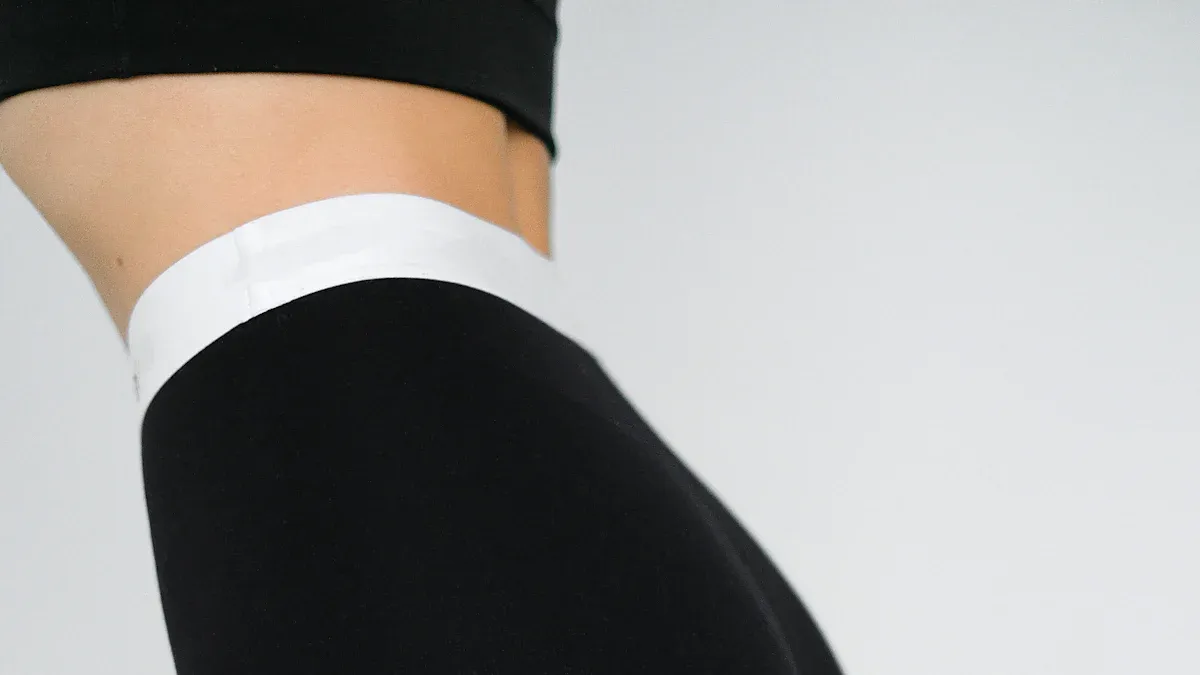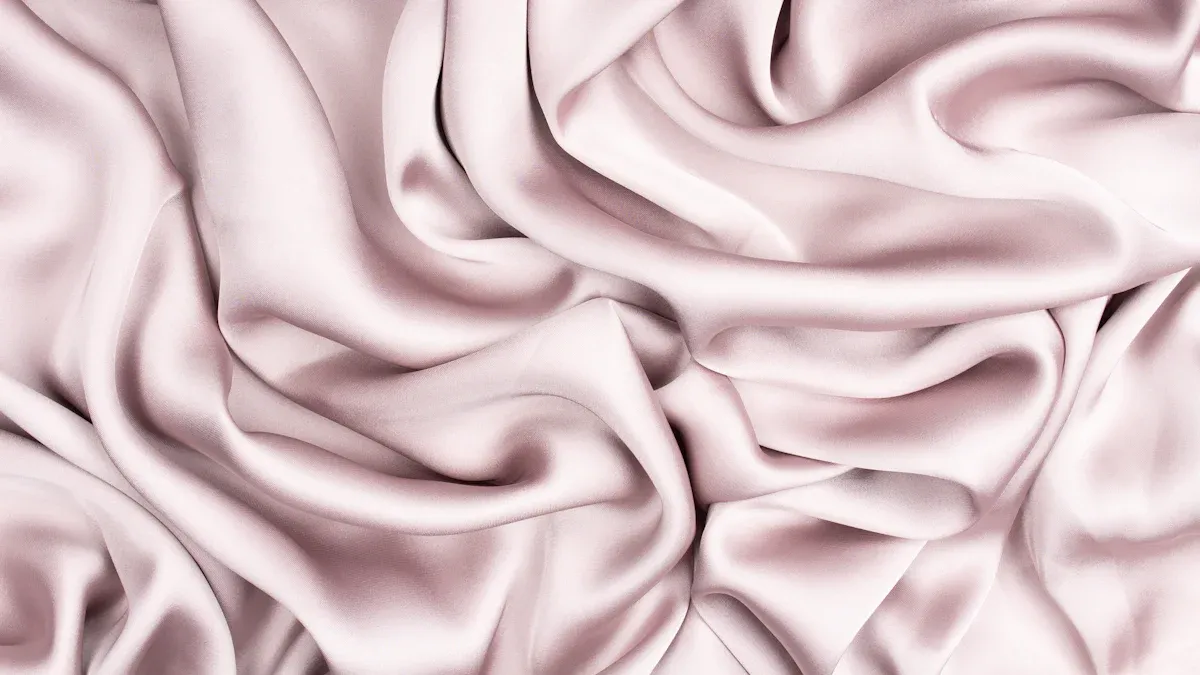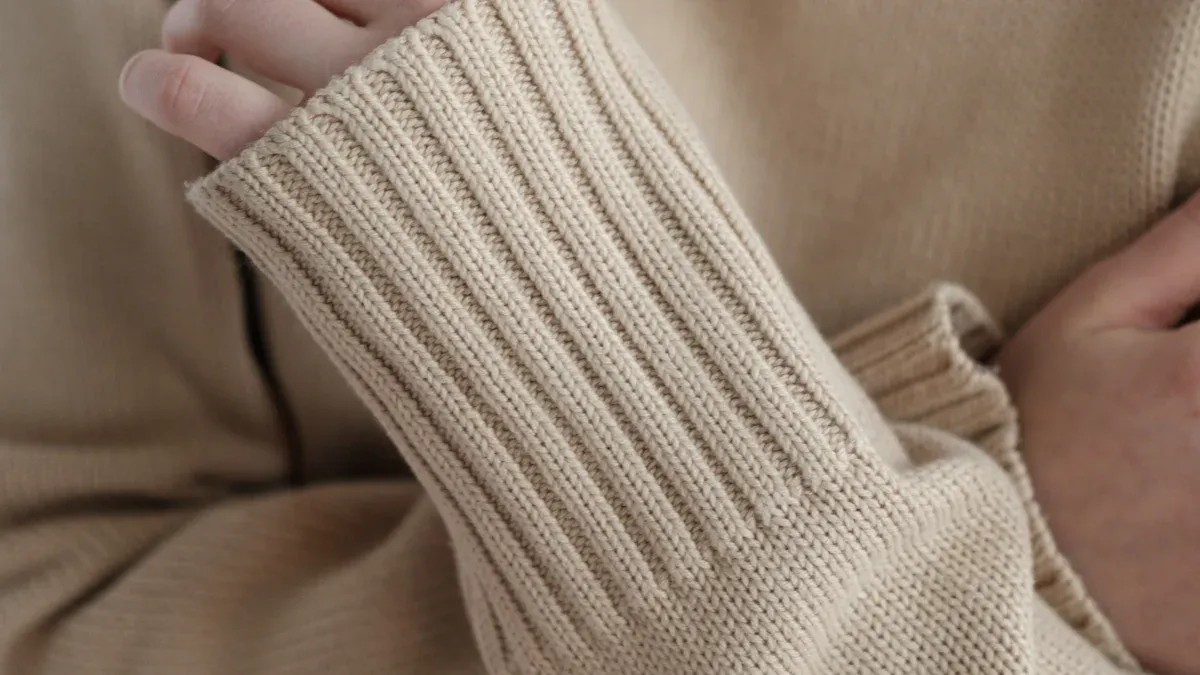
Chiffon fabric has some problems for daily use. Many people think chiffon material fabric is delicate and hard to take care of. The fabric can snag, tear, and wrinkle very easily. Because it is light, it can lose its shape and not hang well, especially in clothes. The table below shows common problems found by textile industry surveys:
| Disadvantage | Description |
|---|---|
| Poor drape | Chiffon can lose shape or loosen because of its structure. |
| Deformation | Its light weight makes it change shape easily. |
| Pilling | Pilling on the surface changes how it looks and feels. |
Some people also see that chiffon pills, which can make it look less nice.
Common Sewing Challenges Encountered When Working with Chiffon Fabric
It is hard to sew chiffon, especially for beginners. The fabric is very delicate and can get damaged easily. You need special tools and methods to sew it well. These problems make many new sewers avoid using chiffon.
Slippery Texture of Chiffon Makes Sewing Difficult
Crepe chiffon fabric is slippery and moves around a lot. It is hard to keep the pieces in place. This makes cutting and sewing tricky. Some people put a towel on the table to stop it from sliding. Pattern weights help hold the fabric instead of pins, which can leave marks. Spray starch can make chiffon less slippery before cutting. A walking foot helps the fabric move evenly in the machine. Lowering the presser foot pressure can help stop shifting. Sharp needles for delicate fabrics work best and should be changed often. French seams are good for keeping edges neat and strong.
Fraying Edges of Chiffon Fabric During Sewing
Chiffon frays quickly at the edges. This makes it hard to finish clothes neatly. Beginners often have trouble with fraying, which can ruin the look. The table below lists common sewing problems with chiffon:
| Challenge | Explanation |
|---|---|
| Fragility | Chiffon is delicate and can be damaged by large needles or rough handling. |
| Fraying | Cut edges fray quickly, needing careful finishing techniques. |
| Pin Holes | Regular pins leave visible holes; silk pins or basting are better choices. |
| Cutting Difficulty | Cutting one layer at a time with sharp scissors helps prevent mishaps. |
| Stitching Issues | Shorter stitch length and slow speed prevent bunching and puckering. |
French seams help hide raw edges and stop fraying. Lightweight interfacing with small glue dots can keep seams stable. Basting is better than pinning to avoid holes. Fine cotton or polyester thread matches chiffon and keeps seams smooth. Many people practice on scraps before sewing their main project. Silk or rayon chiffon is easier for beginners than polyester chiffon.
Durability Issues That Affect the Longevity of Chiffon Fabric
How Snags and Tears Easily Damage Chiffon Material
Blended chiffon fabric is famous for its delicate and airy feel, but this quality also makes it easy to damage. Many people notice that chiffon snags and tears much faster than other lightweight fabrics. Silk chiffon, in particular, is very fragile. Polyester and nylon chiffon are a bit stronger, but they still need gentle handling. Everyday activities can cause problems for chiffon fabric. For example, brushing against a rough wall or catching on a piece of jewelry can leave a visible snag or even a tear.
Chiffon often gets damaged by:
- Contact with rough or sharp surfaces, like zippers or jewelry.
- Dry air, which increases static and makes the fabric stick to things.
- Loose seams or poor stitching, which can pull apart easily.
People who wear chiffon dresses or blouses for special events may not notice many problems. However, those who use chiffon for everyday clothing often see snags and fraying after only a few wears. Chiffon fabric does not hold up well to rough handling or frequent washing. This makes it a poor choice for items that need to last a long time or go through a lot of use.
The Weakness of Chiffon Fabric When It Becomes Wet
Chiffon, especially silk chiffon fabric, becomes even weaker when it gets wet. Silk does not absorb water quickly, so moisture stays on the surface. This can make the fabric feel damp and uncomfortable during hot or humid weather. Unlike cotton, silk chiffon does not let the skin breathe well. The fabric can stretch or tear more easily when wet, so washing or wearing it in the rain can cause damage.
- Silk has a hydrophobic nature, so water sits on the surface.
- Moisture can make the fabric feel sticky against the skin.
- Silk chiffon does not work well in humid or sweaty conditions.
Chiffon’s lack of durability is a big problem for garments that get a lot of use, like shirts, skirts, or scarves. People who want a long-lasting, lightweight fabric for daily wear may want to choose something other than chiffon.
Essential Fabric Care Tips Specifically for Maintaining Chiffon
The Importance of Dry Cleaning to Preserve Chiffon Fabric
Chiffon needs special care to stay nice. Most chiffon clothes should be dry cleaned. Regular washing can hurt the fibers. Dry cleaning stops shrinking and keeps the fabric soft. Some people wash chiffon by hand in cool water with gentle soap. Machine washing is not safe for chiffon. If you must, use a mesh bag and gentle cycle if the label says it’s okay. Never twist or wring chiffon after washing. This can stretch or rip the fabric. Lay it flat on a towel to dry so it keeps its shape.
Tip: If you spill something, blot it softly. Do not scrub. Ask a cleaner for help with tough stains.
Heat Sensitivity of Chiffon and Its Effects on Fabric Quality
Chiffon does not like heat. Hot water, steam, or hot irons can ruin it. Always iron on low heat with a cloth on top. Turn the clothing inside out before ironing to protect it. Some people use a steamer on the lowest setting. Still, you must be careful. Polyester chiffon can melt if it gets too hot. Silk chiffon can burn or lose its shine. Always read the care label before using heat.
| Care Step | Recommendation |
|---|---|
| Ironing | Use low heat, pressing cloth, inside out |
| Drying | Lay flat, avoid direct sunlight |
| Storage | Cool, dry place, padded hangers |
The Tendency of Chiffon to Wrinkle Easily and How to Manage It
Chiffon georgette fabric is very light and wrinkles fast. It creases easily after washing or wearing. Wrinkles make clothes look messy and not fancy. Because chiffon is thin, wrinkles show up a lot and are hard to fix. Hang chiffon in a cool, dry place to stop wrinkles. Some people use steam to get rid of creases, but do it carefully. Store chiffon on padded hangers to keep it smooth and neat.
The Impact of Sunlight Exposure on Chiffon Fabric Over Time

How Prolonged Sunlight Can Cause Color Loss in Chiffon
Chiffon can lose its color in sunlight. The dyes in chiffon do not always stop fading. Bright colors can look dull after a few hours outside. This happens with silk and synthetic chiffon. Chiffon is thin, so sunlight goes through it easily. This makes fading happen faster. People notice their chiffon clothes change color quicker than thick fabrics.
Tip: Keep chiffon clothes in a dark closet to save color.
Some makers use special dyes to slow fading, but they do not last forever. Washing chiffon in cold water helps keep colors bright. Drying chiffon away from sunlight also helps. If you want your chiffon to look new, do not leave it in the sun for long.
| Chiffon Color Care | Recommendation |
|---|---|
| Washing | Use cold water, gentle soap |
| Drying | Air dry in shade |
| Storage | Keep in dark, cool places |
Sunlight Weakening Fiber Strength in Chiffon Material
Sunlight does more than fade colors. It also makes chiffon fibers weak. Ultraviolet rays break the threads and make the fabric fragile. Thin chiffon tears easier after being in the sun for a long time. People who hang chiffon curtains or wear chiffon scarves outside see them get weaker.
Silk chiffon gets damaged the most by sunlight. Polyester chiffon is stronger, but it still gets weak if left outside. The fabric can feel rough or get tiny holes. People should check their chiffon for damage if they use it outside a lot.
- Silk chiffon gets weak fast in sunlight.
- Polyester chiffon lasts longer but still gets weak.
- Thin chiffon needs extra care outside.
People who want strong, colorful clothes may pick other fabrics for outdoor use. Chiffon is best indoors or for special events with little sunlight.
Comfort Concerns Related to Wearing Chiffon in Different Conditions
Why Chiffon Fabric Tends to Stick to Skin When Sweating
Chiffon feels light and cool at first. But it can get sticky in hot weather. The fabric is thin, so it often sticks to your skin. This happens more when you sweat. Many people notice chiffon clings to their arms or back. This sticky feeling can make it hard to wear for a long time. Chiffon does not soak up sweat well. Sweat stays on your skin and does not go away fast. Some people feel even warmer in chiffon because it traps heat.
Note: People in humid places say chiffon feels sticky in summer.
Chiffon can also build up static electricity. This makes it stick to you even more. Static can be annoying when you wear chiffon. You can wear a slip or use anti-static spray. These things help, but they add extra steps when getting dressed.
The Need to Use a Lining with Chiffon for Better Comfort
Chiffon is known for being see-through. This makes clothes look soft and fancy. But it can cause problems if you want to cover up. Most chiffon clothes need a lining or extra layer. Without lining, you can see undergarments and skin. Some people feel exposed or not comfortable.
Common complaints about chiffon include:
- The fabric is delicate and can tear or snag.
- The see-through look means you need extra layers.
- You must clean and store chiffon very carefully.
Adding a lining makes chiffon clothes heavier. It can also make them feel less cool. Linings cost more and need extra care. Some people do not wear chiffon every day because of this. Others pick chiffon only for special events when style is more important than comfort.
Everyday Use Limitations of Chiffon Fabric for Various Activities
Why Chiffon Fabric is Unsuitable for Active or Sportswear
Chiffon does not work well for active wear. The fabric moves easily and feels soft, but it cannot handle rough activities. People who try to wear chiffon for sports or busy days often find problems. The material snags on jewelry, bags, or even fingernails. It tears if someone pulls or stretches it too much. Chiffon does not protect against scrapes or bumps. Most experts say that chiffon is best for gentle use, like parties or special events.
Chiffon slips and slides during movement. It does not stay in place when someone runs or bends. The fabric can catch on sharp objects and rip quickly. People who want clothes for exercise or outdoor play should choose stronger materials.
Many users share these thoughts in reviews. They say chiffon feels nice and looks pretty, but it does not last long in daily life. The fabric needs careful handling, which makes it hard to wear every day.
- Chiffon is lightweight and breathable, so it feels cool in summer.
- The delicate nature of chiffon limits its use for active wear.
- High maintenance makes chiffon less practical for busy routines.
The Generally Short Lifespan of Garments Made from Chiffon
Chiffon fabric does not last as long as other materials. The threads are thin and break easily. Frequent washing or wearing causes the fabric to lose its shape. People notice that chiffon clothes look worn out after a few months. The color fades, and the edges fray. Even with gentle care, chiffon shows signs of aging quickly.
A table below shows common reasons for the short lifespan of chiffon:
| Reason | Effect on Chiffon Clothes |
|---|---|
| Frequent washing | Weakens fibers, causes fraying |
| Sunlight exposure | Fades color, makes fabric brittle |
| Rough handling | Leads to snags and tears |
Chiffon needs special care, like hand washing or dry cleaning. This adds time and cost. Many people find it hard to keep chiffon looking new. For everyday wear, most experts recommend stronger fabrics. Chiffon works best for special outfits that do not get much use.
Chiffon fabric is not easy for daily use. It wrinkles, snags, and tears very fast. Because it is so light, it does not last long. It is also hard to take care of. People who want strong clothes should pick other fabrics. The table below lists some better choices than chiffon.
| Fabric Type | Characteristics | Use Cases |
|---|---|---|
| Crepe de Chine | Smooth on one side, textured on the other, strong and fancy. | Blouses, dresses, light jackets |
| Georgette | Not see-through, heavier than chiffon, not shiny, a little stretchy. | Layers in clothes and bags |
| Moroccan crepe | Heavier, has lines you can feel, looks fancy. | Fancy clothes, home decorations |
| Crepe Back Satin | Two sides, one is shiny, good for many styles. | Wedding clothes, accessories, high fashion |
People should think about the good and bad sides before picking chiffon. Fabrics like georgette or crepe de Chine are good if you want style and strength.
FAQ
Is chiffon fabric good for everyday clothes?
Chiffon does not work well for daily wear. The fabric tears and wrinkles easily. People often choose stronger materials for clothes they wear often.
Can someone wash chiffon in a washing machine?
Most experts say no. Chiffon can get damaged in a machine. Hand washing with cold water and gentle soap helps keep the fabric safe.
Why does chiffon need a lining?
Chiffon is see-through. A lining covers skin and undergarments. Many designers add a lining to make clothes more modest and comfortable.
Does chiffon cause skin irritation?
Some people feel itchy or sticky when wearing chiffon, especially in hot weather. The fabric does not absorb sweat well. Wearing a slip or lining can help.



